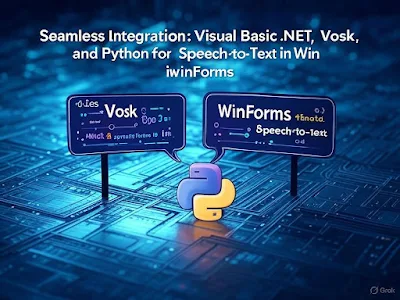How to Install Python and Vosk on Windows 11(64-bit) for Your Visual Basic Transcription Project
Published on April 26, 2025 by Ahmed Samir (@evry1falls)
Are you a Visual Basic .NET developer looking to add speech-to-text 'STT' functionality to your WinForms application? In this tutorial, I’ll show you how to install Python and the Vosk speech recognition library on Windows 11 (64-bit) and integrate it with your Visual Basic project. Vosk is a powerful, open-source, offline speech recognition tool, perfect for transcription projects. Let’s get started!
👇 Why Use Vosk for Transcription?
Vosk offers offline speech recognition, supports multiple languages, and is lightweight, making it ideal for developers building transcription features without relying on cloud APIs. By combining Vosk’s Python-based speech recognition with Visual Basic .NET, you can create robust desktop apps that transcribe audio files or live microphone input.
📃Prerequisites
- Windows 11 (64-bit)
- Visual Studio(2017 or later) with a VB.NET WinForms project
- Basic familiarity with Python and command-line tools
Step 1: Install Python on Windows 11
Python is required to run Vosk. Follow these steps to install it:
- Visit the Python website and download the latest Python 3.8 installer (64-bit) for Windows. Vosk works best with Python 3.8 on Windows.
- Run the installer. Check the box toAdd Python 3.8 to PATHto make Python accessible from the command line.
- ChooseCustomize installationand ensure pip (Python’s package manager) is included.
- Complete the installation and verify by opening a Command Prompt and typing:
You should see something likepython --versionPython 3.8.10.
Step 2: Install Vosk and Dependencies
Now, let’s install Vosk and its required libraries:
- Open a Command Prompt and upgrade pip:
Ensure pip is version 19.0 or newer (pip install --upgrade pippip --version). - Install Vosk: [vosk-model-en-us-0.22]
pip install vosk - Install
sounddevicefor microphone input (optional, if you want live transcription):pip install sounddevice - Download a Vosk model for English from Vosk’s model page. I recommend
vosk-model-en-us-0.22for accuracy. Extract the zip file to a folder, e.g.,C:\Vosk\model.
Step 3: Test Vosk with a Python Script
Your project's structure could be:
Desktop\TranscriptionProject\
1) model\ # Vosk model folder (e.g., vosk-model-en-us-0.22)
2) *.Wav file
3)transcribe.py
Let’s create a Python script to transcribe an audio file. Save this astranscribe.py in your project folder:
Vosk works best with WAV files that are mono and sampled at 16kHz. If your audio is in another format (like MP3), convert it first using a tool like Audacity.
Save the Audio:
Place your audio file (e.g., audio.wav) in the Transcription Project folder.
import sys
from vosk import Model, KaldiRecognizer
import wave
import json
# Check for correct number of arguments
if len(sys.argv) != 4:
print("Usage: python transcribe.py ")
sys.exit(1)
# Get arguments
audio_file = sys.argv[1]
output_file = sys.argv[2]
model_path = sys.argv[3]
# Load the Vosk model from the provided path
model = Model(model_path)
# Example transcription code (adjust as needed)
wf = wave.open(audio_file, "rb")
rec = KaldiRecognizer(model, wf.getframerate())
while True:
data = wf.readframes(4000)
if len(data) == 0:
break
if rec.AcceptWaveform(data):
result = json.loads(rec.Result())
with open(output_file, "a") as f:
f.write(result.get("text", "") + "\n")
final_result = json.loads(rec.FinalResult())
with open(output_file, "a") as f:
f.write(final_result.get("text", "") + "\n")
Note: Your audio file (test.wav) must be mono and 16kHz. Use tools like Audacity to convert MP3s to the correct format. Run the script with:
python transcribe.pyStep 4: Integrate Vosk with Your Visual Basic .NET Project
To use Vosk in your WinForms app, call the Python script from VB.NET. Here’s an example to runtranscribe.py and display the output:
Imports System.Diagnostics
Imports System.IO
Public Class Form1
Private audioFilePath As String
Private modelPath As String
' Handle "Select Audio File" button click
Private Sub btnSelectFile_Click(sender As Object, e As EventArgs) Handles btnSelectModel.Click
Dim openFileDialog As New OpenFileDialog()
openFileDialog.Filter = "WAV files (*.wav)|*.wav|All files (*.*)|*.*"
If openFileDialog.ShowDialog() = DialogResult.OK Then
audioFilePath = openFileDialog.FileName
lblModelPath.Text = audioFilePath ' Update label with selected file path
End If
End Sub
' Handle "Select Model Folder" button click
Private Sub btnSelectModel_Click(sender As Object, e As EventArgs) Handles btnSelectModel.Click
Dim folderDialog As New FolderBrowserDialog()
If folderDialog.ShowDialog() = DialogResult.OK Then
modelPath = folderDialog.SelectedPath
lblModelPath.Text = modelPath ' Update label with selected model path
End If
End Sub
' Handle "Transcribe" button click
Private Async Sub btnTranscribe_Click(sender As Object, e As EventArgs) Handles btnTranscribe.Click
If String.IsNullOrEmpty(audioFilePath) Then
MessageBox.Show("Please select an audio file first.")
Return
End If
If String.IsNullOrEmpty(modelPath) Then
MessageBox.Show("Please select the model folder first.")
Return
End If
btnTranscribe.Enabled = False
txtTranscription.Text = "Transcribing... Please wait."
Dim outputFile As String = Path.GetTempFileName()
Dim scriptPath As String = Path.Combine(Application.StartupPath, "transcribe.py")
' Set up the process
Dim startInfo As New ProcessStartInfo()
startInfo.FileName = "python"
startInfo.Arguments = $"""{scriptPath}"" ""{audioFilePath}"" ""{outputFile}"" ""{modelPath}"""
startInfo.WorkingDirectory = Application.StartupPath
startInfo.CreateNoWindow = True
startInfo.UseShellExecute = False
Try
Await Task.Run(Sub()
Using process As Process = Process.Start(startInfo)
process.WaitForExit()
If process.ExitCode = 0 Then
Dim transcription As String = File.ReadAllText(outputFile)
Me.Invoke(Sub() txtTranscription.Text = transcription)
Else
Me.Invoke(Sub() txtTranscription.Text = "Transcription failed. Check the Python script or audio file.")
End If
End Using
End Sub)
Catch ex As Exception
MessageBox.Show($"Error: {ex.Message}")
Finally
If File.Exists(outputFile) Then
File.Delete(outputFile)
End If
btnTranscribe.Enabled = True
End Try
End Sub
End Class
Add aButton(btnTranscribe) and aTextBox(txtOutput) to your WinForms form. Ensuretranscribe.pyandtest.wavare in your project’s directory.
🛬Troubleshooting Tips
- Python not found: Verify Python is added to PATH (
python --versionshould work). - Vosk installation fails: Ensure you’re using Python 3.8 (64-bit) and pip is updated.
- Model not found: Double-check the model path in
transcribe.py. - Audio format issues: Use Audacity to convert audio to mono, 16kHz WAV.
🔬Conclusion
You’ve now set up Python and Vosk on Windows 11 and integrated speech-to-text into your Visual Basic .NET project! This setup is perfect for educator transcriptions, video subtitles, or custom tools. Want more? Explore my other posts on WinForms development or visit Vosk’s official site for advanced features.
Download the code and try it yourself!
Download Project Files - github♥ Here are some online Visual Basic lessons and courses:














No comments:
Post a Comment